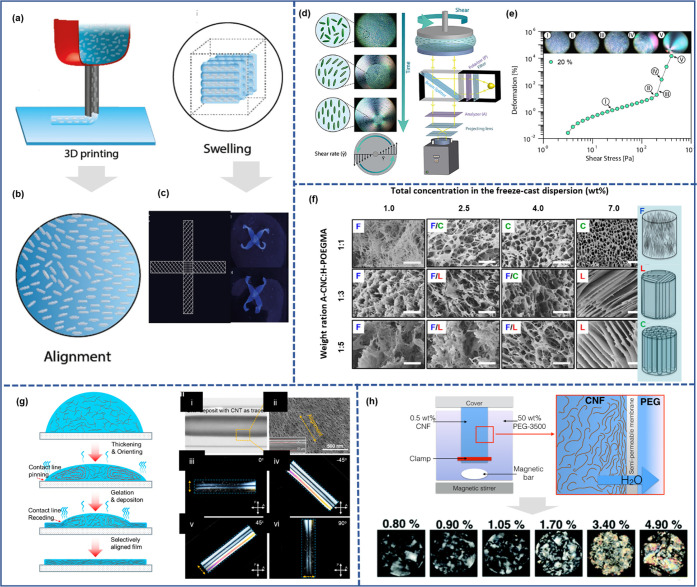Figure 11.
Nanocellulose–water interactions in anisotropic nanostructuring: (a,b) Schematic representation of CNC alignment while exiting the printer’s nozzle,705 (c) directional swelling of the material with aligned CNCs in water, used to create controlled water response.705 (a–c) Adapted from ref (705) under the terms of CC-BY. Copyright 2021 Elsevier. (d,e) In situ polarization rheology to study shear induced CNC alignment.704 (d,e) Adapted from ref (704). Copyright 2018 American Chemical Society. (f) SEM images of aerogels cross-section (the XY-plane perpendicular to the ice crystal-growth direction) with morphologies ranging from fibrillar (F) to columnar (C) to lamellar (L) and their combinations, dependent on A-CNC (aldehyde-functionalized cellulose nanocrystals):H-POEGMA (hydrazide-functionalized poly(oligoethylene glycol methacrylate)) weight ratio and A-CNC+H-POEGMA concentration. Scale bars are 20 μm. (right) Aerogels cast in cylindrical molds.706 (f) Adapted with permission from ref (706). Copyright 2016 American Chemical Society. (g) (left) Schematics showing the formation of a selectively aligned CNF film on a substrate. (right) Photographs of the CNF deposition with a few carbon nanotubes (CNTs) as a visible tracer on top of a transparent PET film.707 (g) Adapted with permission from ref (707). Copyright 2019 Elsevier. (h) Inducing nematic ordering of cellulose nanofibers using osmotic dehydration, images of the CNF suspensions with different concentrations between cross-polars.121 (h) Adapted from ref (121) under the terms of CC_BY. Copyright 2018 The Royal Society of Chemistry.

